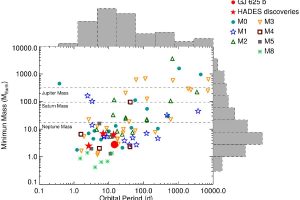A new super-Earth discovered with HARPS-N: Published by A&A the research: “HADES RV Programme with HARPS-N at TNG. V: A super-Earth on the inner edge of the habitable zone of the nearby M dwarf GJ 625” of A. Suárez Mascareño

The family of the potentially habitable exoplanets named “super-Earths” (rocky planets with a mass ranging between 2 and 10 times that of the Earth), counts a brand new member.
On Astronomy & Astrophysics has been recently published the study “HADES RV Programme with HARPS-N at TNG. V: A super-Earth on the inner edge of the habitable zone of the nearby M dwarf GJ 625” of A. Suárez Mascareño (Instituto de Astrofísica de Canarias) describing the discovery of a new super-Earth orbiting the M star GJ 625, only 21.2 light years away from the Sun. The planet has a mass of 2.8 Earth masses, and it orbits with a period of 14.63 days 0.078 AU (Astronomical Units, e.g. the average distance between Earth and Sun) away from its star, within its habitable zone (the region where planets are warm enough to have liquid water on their surface).
The discovery required the analysis of 151 high resolution spectra taken with HARPS-N in 3.5 years. HARPS-N is mounted on the Telescopio Nazionale Galileo and nowadays is one of the best spectrographs dedicated to the search of exoplanets. The project involved the Italian community GAPS (Global Architecture of Planetary Systems), the Institut de Ciències de l’Espai de Catalunya (ICE), and the Instituto de Astrofísica de Canarias (IAC). Among the coauthors of the study are the astronomers Laura Affer, Giuseppina Micela, Jesus Maldonado e Antonio Maggio of the Astronomical Observatory of Palermo.
The figure (link) shows the distribution of planetary mass vs. orbital periods of known exoplanets around M stars.
